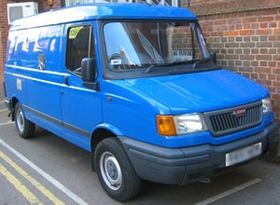Leyland DAF 200 Series
| LDV Pilot | |
|---|---|

1999 LDV Pilot
|
|
| Overview | |
| Manufacturer | LDV Limited |
| Production | 1996–2006 |
| Body and chassis | |
| Class | Van |
| Related | LDV Convoy |
| Chronology | |
| Predecessor | Leyland DAF 200 Series |
| Successor | LDV Maxus |
| Leyland Sherpa | |
|---|---|
 |
|
| Overview | |
| Manufacturer | British Leyland (Austin Morris) |
| Also called | Morris Sherpa |
| Production | 1974–1982 |
| Body and chassis | |
| Class | Van |
| Chronology | |
| Predecessor | Morris J4 |
| Successor | Freight Rover Sherpa |
| Freight Rover Sherpa | |
|---|---|
 |
|
| Overview | |
| Manufacturer | Freight Rover |
| Production | 1982–1984 |
| Body and chassis | |
| Class | Van |
| Chronology | |
| Predecessor | Leyland Sherpa |
| Successor | Freight Rover 200 Series |
| Freight Rover 200 Series | |
|---|---|
| Overview | |
| Manufacturer | Freight Rover |
| Production | 1984–1989 |
| Body and chassis | |
| Class | Van |
| Related | Freight Rover 300 Series |
| Chronology | |
| Predecessor | Freight Rover Sherpa |
| Successor | Leyland DAF 200 Series |
| Leyland DAF 200 Series | |
|---|---|
 |
|
| Overview | |
| Manufacturer | Leyland DAF |
| Also called | DAF 200 Series |
| Production | 1989–1997 |
| Body and chassis | |
| Class | Van |
| Related | Leyland DAF 400 Series |
| Chronology | |
| Predecessor | Freight Rover 200 Series |
| Successor | LDV Pilot |
| LDV Pilot | |
|---|---|
 |
|
| Overview | |
| Manufacturer | LDV Limited |
| Production | 1996–2006 |
| Body and chassis | |
| Class | Van |
| Related | LDV Convoy |
| Chronology | |
| Predecessor | Leyland DAF 200 Series |
| Successor | LDV Maxus |
The LDV Pilot is a panel van that was produced by LDV Limited from 1996 until 2006, and closely based on preceding models dating back to 1974 (which were in turn related to older models).
The Pilot was available in capacities from 2.2 to 2.6 tonnes in a 5.7 cubic metres (200 cu ft) load area. Power came from a 1.9 litre Peugeot diesel engine driving the rear wheels through a five speed gearbox. Access to the load area is from either the rear or a sliding side door.
Derived from the Morris/BMC J4 and JU250 vans of the 1960s, the core vehicle went through a series of developments, the main one being the revision of the forward control layout of the J4 and moving the engine ahead of the cab and accessible via a bonnet. This allowed the wheelbase to be extended resulting in greater stability, payload, side loading and the distinctive 'Sherpa' profile (though the last of the J4s and the first Sherpa are largely identical from the rear).
The Sherpa gave way to the Freight Rover 200 Series and in turn the Leyland DAF 200 Series before finally becoming the Pilot after LDV was formed in 1993. It was originally designed to be built on car production lines which led to it having a narrow track. This feature was made into a virtue in later publicity by stressing its ability in narrow city streets – this indeed was why the Sherpa series was for many years, preferred over the Ford Transit by the Royal Mail, in particular.
Originally developed by British Leyland the model was launched in 1974 under the nameplate Leyland Van. A year later the name of the model was changed to the Leyland Sherpa. The Sherpa would then be branded by Morris and later Freight Rover.
The initial Sherpa line up consisted of vans in 185, 215 and 240 versions (where 185 denotes a GVW of 1.85 tons, and so on); pick ups in 215 and 240 versions; a 240 crewbus and minibus; and various chassis cab options in 220 and 250 versions. Payloads were quoted as 13/14cwt for the 185; 18/19cwt for the 215 and 220; and 22/23cwt for the 240 and 250. Loadspace, at 190 cubic feet (5.4 m3), was considerably higher than that of the J4 and only just short of the 250JU's.
In 1978 the 1.7 and 2.0 litre O series engines replaced the original 1622 cc and 1798 cc B series petrol units, while the 1798 cc B series diesel stayed put. The range was redesignated accordingly: vans: 200, 230 and 250; pick ups: 230 and 250; minibus and crewbus: 250 only; chassis cab: 255 only. A few months later, the Sherpa was rebadged as a Morris. In 1981, BL created the Freight Rover division as part of the Land Rover group, so the Sherpa's badges were changed again.
...
Wikipedia
